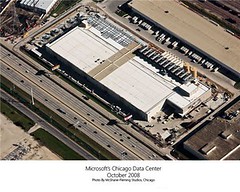Inside Microsoft’s Chicago Data Center
October 1st, 2009 : Rich Miller
A view of the container area in the new Microsoft data center in Chicago (click to see a larger version of this image).
Microsoft’s new $500 million Chicago data center is one of the largest data centers ever built, spanning more than 700,000 square feet. But it’s also one of the most unusual, with its garage-like lower level optimized for 40-foot shipping containers packed with web servers, while a second story houses traditional raised-floor data center space. Microsoft opened the facility for a tour on Sept. 30.
About a dozen parking spaces in the ”container canyon” (shown above) are occupied by containers packed with servers and, in some cases, equipment to power and cool the servers. Each row of containers plugs into a spine providing hookups on the lower level, with power distribution equipment on a mezzanine level. With double-stacked containers, portable stairs can be wheeled in to provide access for maintenance.
This view of the container area also provides a look at the ceiling, where you can see large ductwork for the cooling system, as well as the extensive conduits for power and fiber.

The interior of a 40-foot container inside the new Microsoft Chicago data center, packed with servers on either side of a center aisle (click to see a larger version of this image).
One of the advantages of a container-based design is that the facility needs only to provide the hookups for electricity, chilled water and network connectivity. This setup can accomodate containers – known as “Pre-Assembled Components” or PACs – from different vendors featuring a variety of designs and technology.
The container pictured above uses a center aisle configuration, with rows of equipment on either side.
Rich Miller

More than 2,000 servers can fit inside a container, with the tight space allowing for granular control of airflow and cooling. The density is ideal for providing scalability for the Microsoft Live online services powered by the Chicago facility.
Other containers used in Microsoft’s new Chicago facility feature a “side aisle” configuration, with a single row of densely packed servers. In addition to flexibility in the IT gear inside the box, Microsoft’s approach also works with cooling equipment residing in the same container as the servers or in a separate unit.
“We publish an RFP (Request for Proposal) spec, and vendors can do single stack or double stack,” explained Sean Farney, Microsoft’s data center manager for the Chicago facility. The containers come pre-populated with servers and support equipment, eliminating the need to unpack and install 2,000 servers.
t, 2009 : Rich Miller

A look at the water storage towers at the Chicago data center site during construction last winter.
With 700,000 square feet of space and the potential to hold as many as 300,000 servers, the Chicago facility requires some industrial strength infrastructure. That includes:
- 11 diesel generators, each supplying 2.8 megawatts of power
- 11 electrical substations and power rooms
- 12 chillers, each with a capacity of 1,260 tons
There’s also an extraordinary amount of electric conduit and enormous cooling ducts and water pipes to move the power and cooling throughout the facility.
2009 : Rich Miller

The entrance to the new Microsoft data center in Northlake, Ill.
Microsoft has completed the first phase of its Chicago data center, which can accommodate as many as 56 data center containers. When additional capacity is needed, a second phase that can hold an additional 56 containers will be brought online. The facility also has four 12,000-square-foot server rooms on its upper level that use a traditional raised design with a hot and cold aisle.
That’s a lot of capacity, aligned with Microsoft’s great expenctations for its cloud computing operations. “Today’s opening is the next evolutionary step in building out our cloud computing infrastructure,” said Arne Josefsberg, General Manager of Infrastructure for Microsoft Global Foundation Services.
Want to see even more? Microsoft has posted a video of one of the containers being installed in the Chicago facility (a process we described in our coverage yesterday). You’ll need to have Microsoft’s Silverlight installed to view the video.
Microsoft (www.microsoft.com) gave a tour of its massive 700,000 square foot data center in a Chicago suburb, which features 40-foot-long containers packed with servers.First announced in June via its blog, along with its Dublin facility, the Northlake data center began operations July 20th to support Microsoft's Software-plus-Services strategy and the new Bing search engine, as well as other online services.
The $500 million data center was scheduled to open a few months earlier, but Microsoft delayed things due to the ongoing recession.
The data center offers 30MW of critical power in Phase 1 with an additional 30MW to be pre-positioned for future growth.
Currently, the facility can house up to 56 containers, and will double the amount in its second phase, which is currently in the form of shell space. All together, the data center will hold 112 containers with 224,000 servers.
The enormous lower level has a high ceiling and diagonal parking spaces where the container stacks are stored.
There are already 12 containers installed, comprised of 10 double-stacked versions and two single-story containers.

The facility uses outside air to reduce its use of chillers, which require a lot of energy. Despite having 12 large chillers on site, Microsoft says it will only resort to using them when the temperature is too warm to use economization.
Located in a warehouse in an industrial district, which the company would not disclose, the area is ideal in that it is close to affordable and abundant power, and is at the top of a major Internet connection point that houses major east-west and north-south fiber routes.

No comments:
Post a Comment